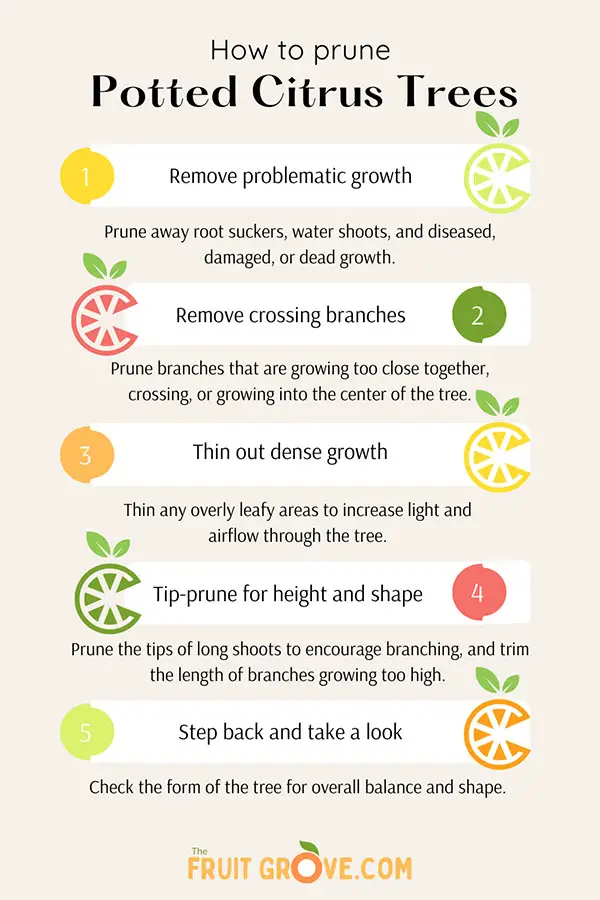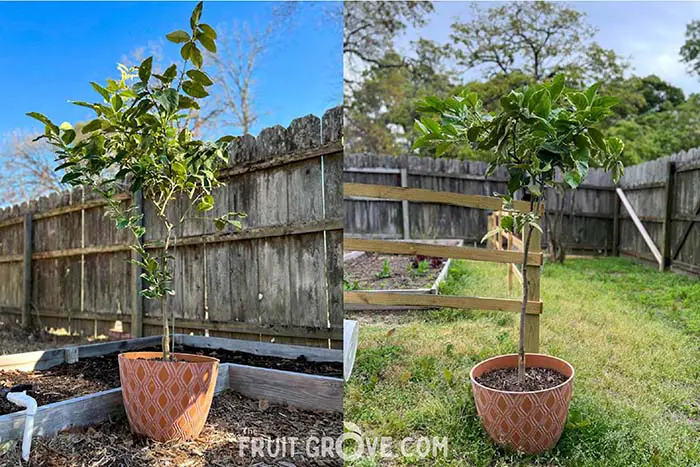
We may receive commissions from purchases made through links in this post, at no additional cost to you.
I have several lemon and lime trees growing in containers in my backyard Fruit Grove. I love the way citrus looks in pots – sprawling branches, big bright green or variegated leaves, clusters of bright fruit hanging down. In general, caring for potted citrus is pretty simple. But the one thing I have found to be the most beneficial for my potted lemon and lime trees is pruning.
Pruning often seems intimidating to home gardeners – after all, what if you remove the wrong branch? You can’t put it back on the tree. But in fact, there are many ways to prune “correctly,” even among experts.
Pruning potted citrus trees will improve fruit production, quality, and overall tree health. First remove any diseased or damaged growth, root suckers, crossing branches, or water shoots. Then thin out growth as necessary to maximize light and airflow to the ripening fruit.
Potted citrus trees, in particular, respond very well to moderate annual pruning. The focus of this article is on lemon and lime trees, but the concepts can be broadly applied to any citrus tree.
I’ll walk through the steps to pruning any potted lemon or lime tree. I’ve also included a video where I show exactly how I pruned my ‘Improved Meyer Lemon’ and ‘Variegated Pink Lemon’ trees. But first, let’s look at what the benefits of pruning are for potted lemon and lime trees, and when it’s best to tackle this gardening task.
Do lemon and lime trees even need pruning?
Lemon and lime trees need to be pruned in order to produce the best possible quality and quantity of fruit. Pruning enhances the health of the tree, its productivity, fruit size and quality, and overall appearance.
A lot of online resources say that citrus trees need little to no pruning. To some extent, that’s true – a lemon tree that’s left to grow unchecked will probably still grow and fruit decently. But an unpruned citrus tree could be prone to a number of issues, including disease, overgrowth, and smaller, less flavorful fruit.
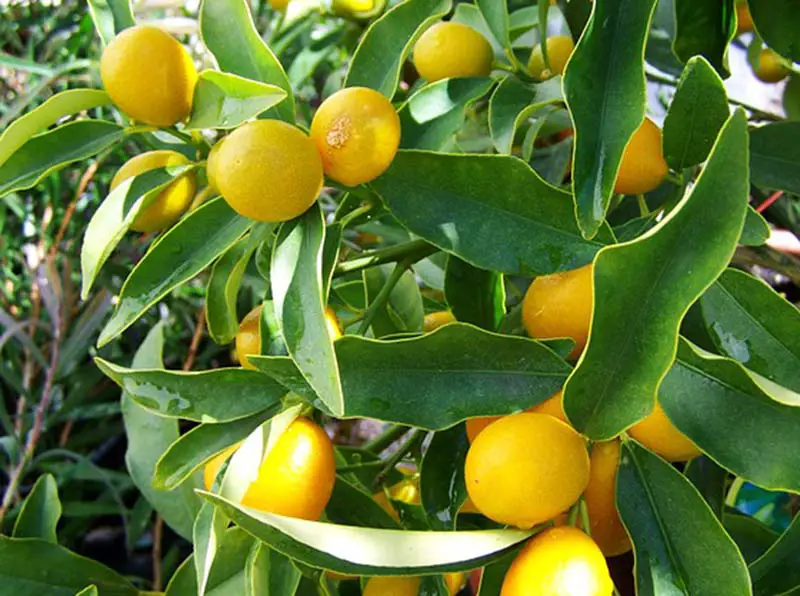
Even a little bit of pruning will be hugely beneficial. It may seem counterintuitive, but removing some growth will actually help the tree produce more lemons or limes, and those fruits will be bigger and better tasting. If a tree has less leafy growth to support, it has more energy to put toward developing fruit.
Selective pruning also opens up the tree structure, increasing airflow around the leaves and fruit. This will help prevent disease and pest issues from taking as strong a hold on the tree. For example, the quicker rainwater evaporates from the leaves, the less likely fungal disease are to develop.
Finally, pruning gives you a chance to assess the form of your lemon or lime tree. If left to its own devices, citrus trees are likely to produce root suckers, nonfruiting water shoots, long, leggy branches, and an excess of leaves. All of these things only detract from the beauty of a potted tree and get in the way of fruit production.
Potted citrus trees, in particular, benefit from yearly pruning. A potted tree is likely to stay more compact since its roots are restricted by the size of the container. But because the tree has limited access to nutrients, keeping the tree’s growth in check will help your potted lemon or lime grow and fruit its best.
When to Prune Potted Citrus Trees (and When NOT To)
The best time to prune any potted citrus tree is after the fruit has been harvested in fall or winter, but before the vigorous spring growth begins. Avoid pruning during winter while there is still a chance of frost, or in the strong summer heat, as this can cause stress to the tree.
Citrus fruit is typically ready to harvest in the late fall or winter, depending on the climate and variety of tree. I live in a warm climate with short winters (USDA zone 8b), so my lemons and limes are usually ripe in December or January.
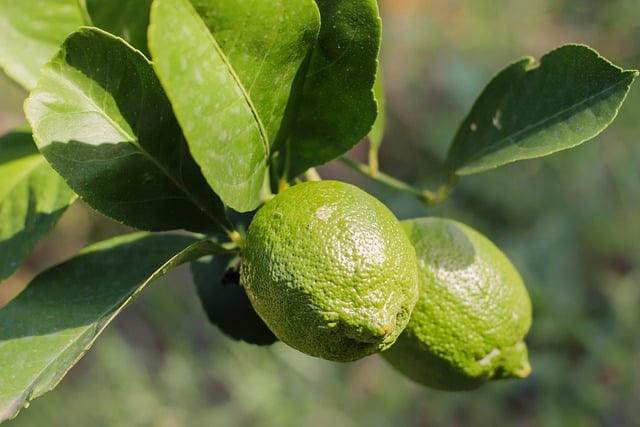
Citrus trees never actually go dormant like many other fruit trees, but their growth does slow down significantly in the winter. In my mild climate, my lemon and lime trees have blossoms and baby fruits forming throughout most of the year. But the most active growth is in the spring and early summer, when the tree pushes out tons of new shoots and blossoms.
The ideal time to prune is after the fruit harvest. Up to that point, the tree’s energy had been put to developing and ripening the lemons or limes, not producing new growth. Pruning right after harvest will signal the tree to start growing and blossoming again.
If your potted citrus trees stay outdoors all year round, wait until after the threat of frost is past. Frost could cause stress or damage to a just-pruned tree. If you bring your potted lemon or lime tree indoors (or into a shed or garage) during winter, prune just before bringing it back outside in the spring.
Once the tree begins to set blossoms and grow more vigorously in the spring and early summer, avoid picking up the pruning shears. Pruning too much during the active growing season, especially in the intense heat of summer, could stress the tree and cause it to drop fruit or have other issues.
The one exception to this is when you notice the three D’s – dead, diseased, or damaged growth. Any time you see a dead branch or twig, or perhaps one that has been damaged by strong winds, go ahead and remove it. Removing diseased growth as well will help minimize the spread of that disease throughout the plant (or to other plants).
What to Know Before You Start Pruning
Gather Your Equipment
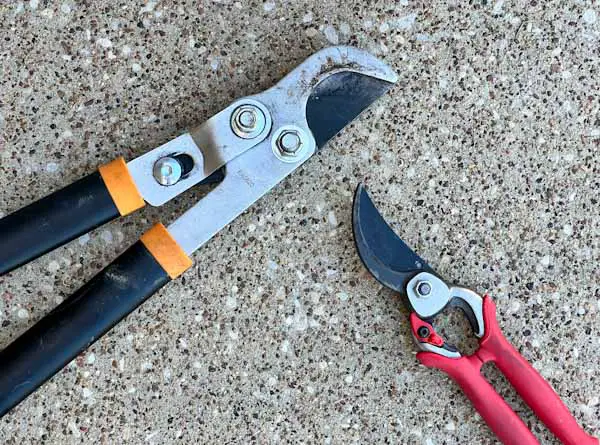
Here’s what you need to prune your potted lemon and lime trees:
- Sharp, clean, good quality pruning shears. In the video below, I used these Corona bypass pruners. They cut cleanly, they’re comfortable to hold, and it’s easy to get replacement blades when you need them.
- Sharp, clean, good quality loppers. These are necessary for cutting branches thicker than a 1/2 an inch or so. Many pruning shears are supposed to cut branches up to an inch thick, but I find that loppers do a better job of making clean cuts to branches a 1/2 inch thick or more. I often use these inexpensive but sturdy Fiskars bypass loppers.
- Gloves. Heavy duty gloves are especially necessary when pruning spiky lime trees. Use leather gloves like these (bonus – these have touch screen-compatible fingertips!) to protect your hands against thorns, sharp tools, and irritation.
Cleaning and Disinfecting Pruning Tools
I highly recommend disinfecting your tools before making any cuts. It doesn’t have to be complicated – just squirt some isopropyl rubbing alcohol on a clean rag and thoroughly wipe down the tools. This will get rid of any potential fungal spores, bacteria, or other pathogens that could be transferred from plant to plant.
I make it a habit to quickly wipe down my tools after I finish any pruning job. It makes pruning much simpler if I know I can just grab my tools and go, without worrying about any other prep. I keep a bottle of alcohol and some rags in my shed to make it really easy.
Basic Pruning Cuts
A thinning cut is made to remove a whole branch from a tree. This can be a larger branch that attaches to a trunk, or a smaller shoot growing from a main branch. Removing a branch at its point of origin does not cause the tree to produce new growth at that point.
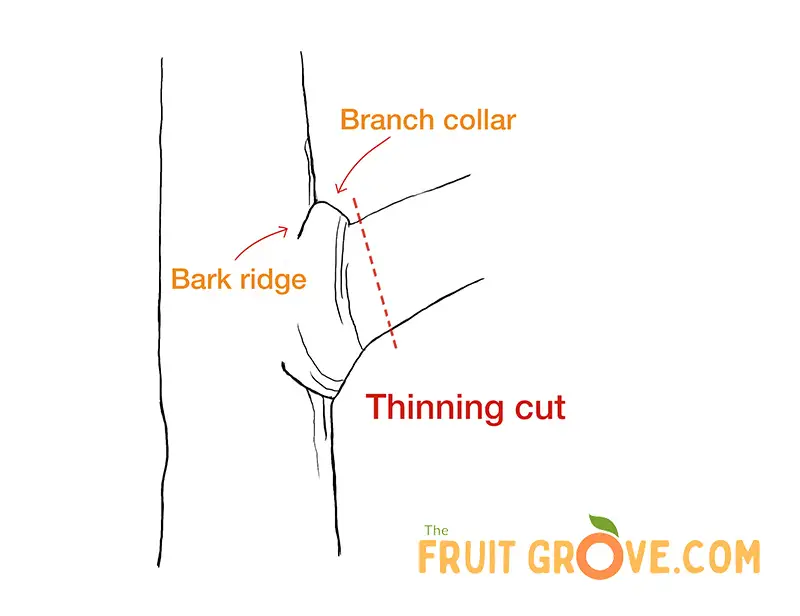
When making thinning cuts, be sure to prune at a slight angle right above the branch collar (the thicker base of the branch where it meets the trunk). This kind of cut will heal well and keep disease or rot from entering the wound.
A heading cut is used to shorten the length of a branch. Heading cuts stimulate growth from the buds or nodes just below the cut, causing new branches to form. Make heading cuts at an angle just above an outward-facing bud.
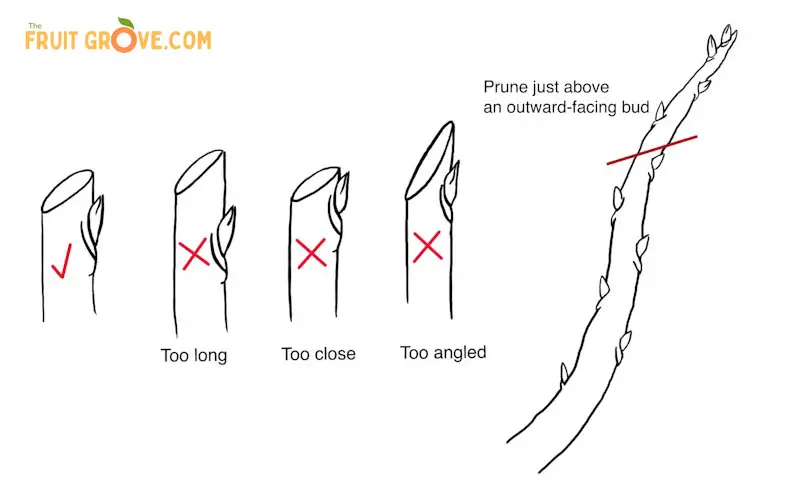
How to Prune a Potted Lemon or Lime Tree
1. Remove root suckers and low growth.
The first step is to remove any growth coming out of the roots or the very base of the plant. Lemon and lime trees can have a bushy, multi-stemmed structure, or they can be trained to have a single central trunk. Either way, use a thinning cut to prune any suckers growing low on the plant. These shoots tend to not produce any blossoms, so they are just using up resources the plant needs for fruiting.
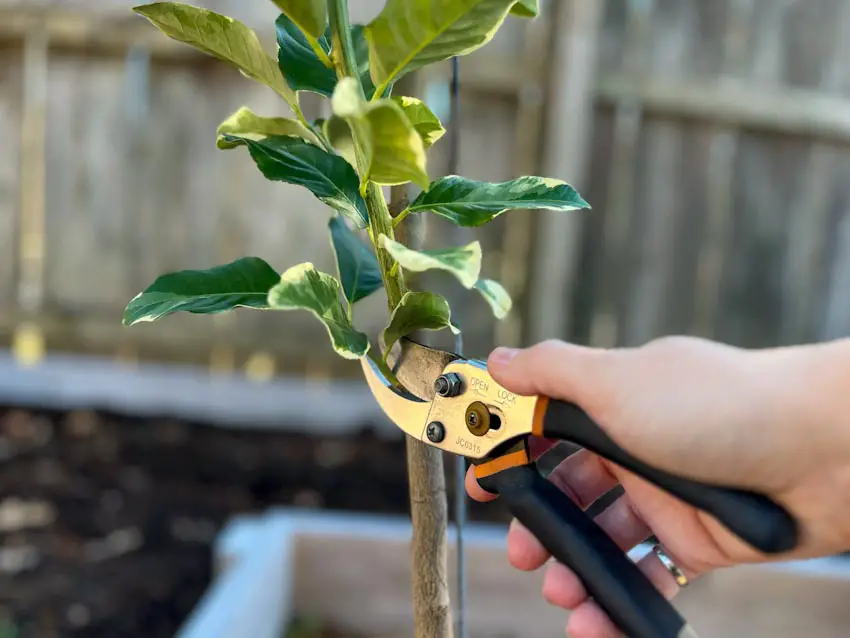
2. Remove vertical water shoots.
These shoots are the one growing straight up from other branches. Like root suckers, they often don’t produce any blossoms or fruit. Thinning these out will improve the airflow through the entire tree.
3. Remove diseased or dead growth.
As soon as you notice a dead or dying branch, or if you see one that was damaged by wind or storms, go ahead and remove it. You can cut the entire branch at its base above the collar, or simply removed the dead portion.
If you see evidence of disease on a particular branch or cluster of leaves, prune it before it can spread to the rest of the tree. Pruning diseased growth is one of the best ways to keep fungal or bacterial infections in check.
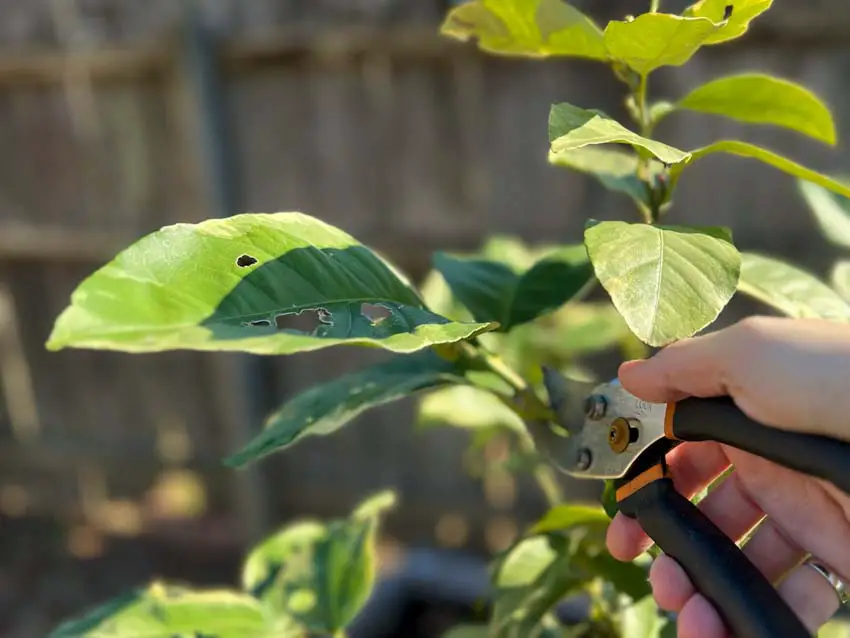
4. Prune crossing or inward-growing branches.
Look for places where two branches cross or are growing very close together and choose one to remove. As these branches continue to grow and thicken, they could fuse together into one thick “super branch,” which is not ideal for the tree’s health. Also prune away branches that are growing into the middle of the tree, especially if they are blocking light from other parts of the plant.
5. Thin out dense, overly leafy areas.
Lemon and lime trees often have very densely compacted leaves. If you notice any areas where the leaves are very crowded, choose a few leaves or twigs to thin out. This will increase light and airflow and help water to evaporate more quickly from the surface of the leaves, preventing disease.
6. Tip-prune long, straight shoots to encourage branching.
If you notice any shoots that are growing very long without branching, use a heading cut to remove about a third to a half of the length. This will signal the plant to send out new growth from the few nodes underneath the cut, causing the shoot to branch out.
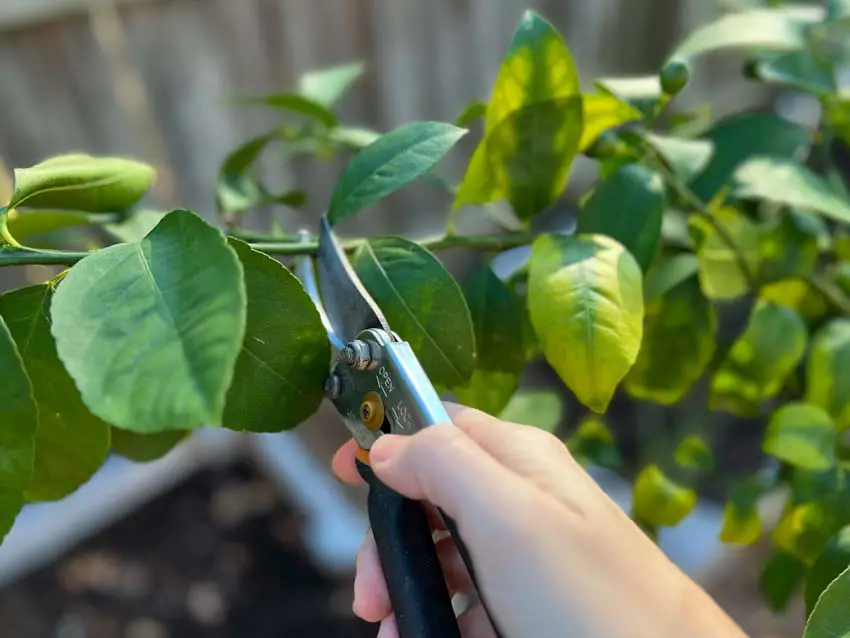
7. Trim top growth to limit height, if necessary.
Depending on the height of your tree, you can trim the top growth to keep the plant more compact. Simply remove any growth that is higher than you want it to be. If you are growing a dwarf tree, such as the popular ‘Meyer’ or ‘Eureka’ lemon trees, trimming the top growth probably won’t be necessary.
8. Step back and assess the form of the tree.
Really you should do this during the entire pruning process. Keep stepping back and walking all around the tree to make sure it looks the way you want. Is it relatively even and balanced? Do you see any dense or overly thin areas? Is the tree lopsided? Do you notice any places you want to encourage more branching?
It’s best to prune to establish the overall form you want while the lemon or lime tree is young – about 2 to 3 years old. As the tree matures, less pruning will be necessary.
9. Thin the fruit, if needed.
About a month after the lemon or lime tree flowers, you may notice that a lot of the baby fruits drop off of the tree. The plant does this because it cannot support all of the developing fruits. Once the remaining fruits are about the size of a nickel, you will still want to manually thin them out.
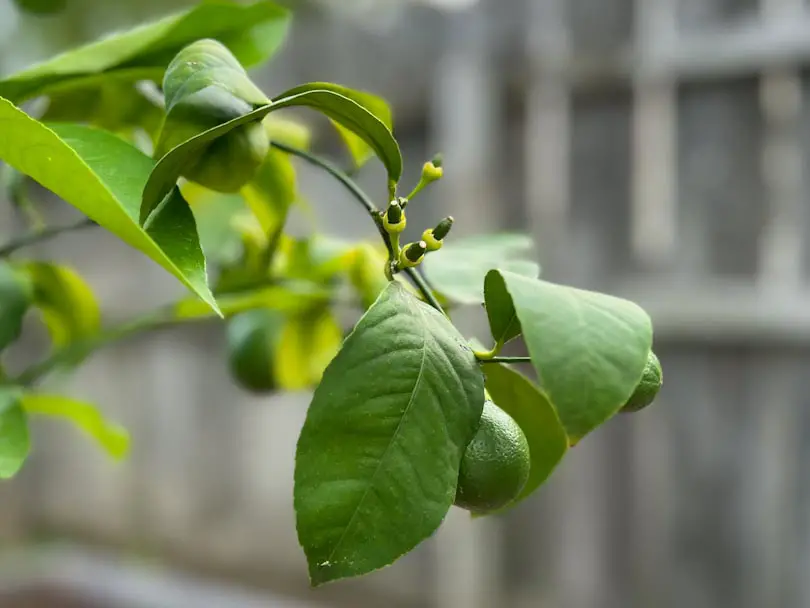
Begin by first removing any damaged or deformed fruits. Take a look at clusters of developing lemons or limes and pinch out the smallest ones. Then look down the branch and pinch out any fruits that are closer than 4-6 inches apart.
Lemons and limes are relatively heavy feeders, so you if you don’t thin them out, the remaining fruit will be small and less flavorful. Be sure to water and fertilize your potted citrus trees regularly to grow the biggest, best lemons and limes.
10. Know when to stop pruning!
The goal is to remove no more than a third of the tree’s overall size each time you prune. Pruning too aggressively could stress the tree, causing it to either grow too vigorously in response, or diminishing the size of the crop. Less is often more when pruning – follow these steps, but don’t get carried away. You can always come back and make a few more cuts if you need to.
Check out this video to see the above pruning steps at work. In the video, I walk through the whole pruning process, including how I choose which cuts to make. You can easily see what the trees look like before and after pruning.
At-a-Glance Steps for Pruning Potted Lemon and Lime Trees
